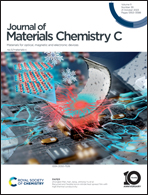Room temperature fabrication of highly proton conductive amorphous zirconia-based thin films achieved through precise nanostructure control†
Abstract
Amorphous ZrO2 and YSZ thin films with controlled microstructures were fabricated using PLD with an ArF excimer laser at room temperature, so as to attain high proton conductivity without the use of high temperature annealing. The density of the film was largely modulated from 5.9 to 1.6 g cm−3 by varying the PO2 condition during deposition. In the resulting relatively porous thin films, proton conductivity increased rapidly near room temperature with an activation energy as large as −2.5 eV, reaching 6.66 × 10−4 S cm−1 for ZrO2 and 1.38 × 10−4 S cm−1 for YSZ thin films. The proton conductivity obtained in this study was higher than that exhibited by polycrystalline YSZ pellets (∼10−5 S cm−1), even though the employed thin films were amorphous. To date, such high proton conductivity has been achieved only with polycrystalline YSZ thin films, which require the use of a high temperature annealing process. These results indicate that the origin of the high proton conductivity is attributed to variations in porosity and the local structure around Zr atoms which are controlled by the PO2 levels. The present study evidences that a solid electrolyte thin film with high proton conductivity can be fabricated at room temperature throughout the fabrication process, which in turn expands the applicability of proton-conducting solid electrolytes to a wide range of electrochemical devices.



 Please wait while we load your content...
Please wait while we load your content...